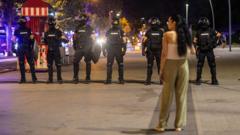As protests against President Aleksandar Vucic's administration continue to escalate, participants are adapting their strategies to exert pressure for change. This past weekend saw a massive gathering in Belgrade, where approximately 140,000 protesters convened, notably led by students who have been at the forefront since the protests commenced last November. In a surprising turn, these students announced that they would step back from leading the demonstrations, setting a deadline for the government to initiate fresh elections, which ultimately was not met.
Consequently, they called upon various groups to take over leadership, thereby launching a campaign of civil disobedience. In the days following the announcement, makeshift roadblocks began appearing across major cities like Belgrade, Novi Sad, and Nis. Participants are utilizing everyday items such as dustbins and chairs to obstruct traffic, with local associations, dubbed "citizens' assemblies," playing a pivotal role in this new phase of protest.
As police efforts to dismantle these blockades ramp up, incidents of excessive force have triggered significant backlash. Reports indicate numerous arrests and injuries, with students particularly affected. The situation has spurred various voices, including civil society groups, political opposition, and even the Serbian Orthodox Church, to condemn police actions. The EU also expressed concerns regarding the escalating violence and urged a return to peace.
Despite the growing tension and disruption caused by these roadblocks, the effectiveness of this new tactic remains uncertain. Some citizens liken the atmosphere to casual street parties rather than a structured form of protest, raising questions about whether this shift can revive momentum after months of rallies.
Initially sparked by public outrage over the tragic collapse at Novi Sad railway station last November, which resulted in the loss of 16 lives, the ongoing protests have evolved from calls for accountability to broader demands for governmental change. The public's discontent has long been brewing under Vucic's leadership style since he assumed power in 2012, and while some citizens have supported his administration for economic growth, many are now seeking more transparency and accountability.
Months of demonstrations have garnered substantial public support yet have struggled to achieve significant political shifts, illustrated by the resignation of Prime Minister Milos Vucevic, who was swiftly succeeded by another Vucic ally. This situation mirrors sentiments from the early 2000s when student-led initiatives played a crucial role in toppling the regime of Slobodan Milosevic, though the current political landscape remains favorable to the SNS, which enjoys high popularity among voters.
As the protests continue, the question looms: who will yield first in this standoff? With summer heat intensifying, both participants and authorities prepare for what could potentially become a pivotal moment in Serbia's political landscape.




















